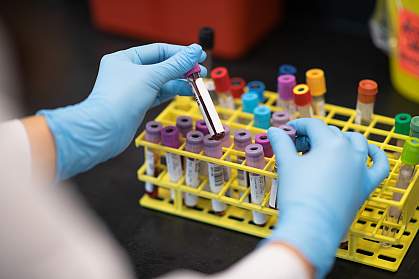You are here
June 29, 2021
Testing a blood biomarker for neurodegeneration
At a Glance
- A biomarker in blood could identify the presence of neurodegeneration in people with cognitive impairment.
- The biomarker could potentially be used to quickly screen for neurodegeneration in the clinic.

Neurodegenerative diseases cause progressive damage and death to nerve cells. This leads to problems in thought, attention, and memory. Reliable and accessible biomarkers would enable the early diagnosis and treatment of such diseases.
One potential biomarker is a protein called neurofilament light chain (NfL). NfL is released when nerve cells are damaged. Elevated NfL concentrations are found in cerebrospinal fluid (CSF) in most neurodegenerative disorders. But CSF collection is an invasive procedure. This limits the use of CSF NfL for routine diagnosis.
NfL concentrations in blood correlate strongly with those in CSF. This suggests that blood NfL could be a less invasive biomarker. Toward this end, a research team led by Drs. Nicholas Ashton, Abdul Hye, and Oskar Hansson—based at the University of Gothenburg, King’s College London, and Lund University in Sweden—measured blood NfL concentrations in more than 2,200 people. The team also included scientists from NIH’s National Institute on Aging (NIA).
The study participants came from Europe, Canada, and the U.S. They included people with 13 neurodegenerative disorders, Down syndrome, and depression. Unimpaired controls were also included. Results appeared in Nature Communications on June 7, 2021.
The researchers found elevated NfL concentrations in people with various forms of dementia. They also found elevated NfL concentrations in those with amyotrophic lateral sclerosis (Lou Gehrig’s disease) and atypical parkinsonian disorders.
NfL concentrations were not disease-specific. Thus, NfL alone could not distinguish between different types of cognitive disorders. But it could aid in diagnosing patients. For example, NfL concentrations could distinguish Parkinson’s disease from atypical parkinsonian disorders such as multiple system atrophy, corticobasal syndrome, and progressive supranuclear palsy. Among people with Down Syndrome, NfL could distinguish those with and without dementia.
NfL could also distinguish moderate and severe depression from neurodegenerative disorders with 90% accuracy or greater. This is important because certain neurodegenerative diseases, such as frontotemporal dementia, cause psychiatric symptoms like depression and anxiety. NfL could help determine whether a patient with depression has such a disease.
The researchers determined threshold NfL levels for determining whether a patient had neurodegeneration. Using separate thresholds for people older and younger than 65 years of age improved the diagnostic accuracy. In all age groups, the researchers found accurate thresholds for diagnosing neurodegeneration. Diagnosis based on these thresholds yielded very few false positives.
The results suggest that blood tests for NfL could be used to detect neurodegenerative diseases in the clinic. “For the first time we have shown across a number of disorders that a single biomarker can indicate the presence of underlying neurodegeneration with excellent accuracy,” Hye says. “Though it is not specific for any one disorder, it could help in services such as memory clinics as a rapid screening tool to identify whether memory, thinking, or psychiatric problems are a result of neurodegeneration.”
—by Brian Doctrow, Ph.D.
Related Links
- Biomarkers Predict Concussion Recovery Time
- Blood Tests Show Promise for Early Alzheimer’s Diagnosis
- Blood Proteins Associated with Persistent Symptoms After Brain Injury
- New Blood Test Method May predict Alzheimer’s Disease
- Tracking Parkinsonian Disease Progression
- Boosting Brain’s Waste Disposal System May Slow Neurodegenerative Diseases
- Dealing with Dementia: When Thinking and Behavior Decline
- Alzheimer’s Disease & Related Dementias
- Alzheimer’s Disease Information Page
References: A multicentre validation study of the diagnostic value of plasma neurofilament light. Ashton NJ, Janelidze S, Al Khleifat A, Leuzy A, van der Ende EL, Karikari TK, Benedet AL, Pascoal TA, Lleó A, Parnetti L, Galimberti D, Bonanni L, Pilotto A, Padovani A, Lycke J, Novakova L, Axelsson M, Velayudhan L, Rabinovici GD, Miller B, Pariante C, Nikkheslat N, Resnick SM, Thambisetty M, Schöll M, Fernández-Eulate G, Gil-Bea FJ, López de Munain A, Al-Chalabi A, Rosa-Neto P, Strydom A, Svenningsson P, Stomrud E, Santillo A, Aarsland D, van Swieten JC, Palmqvist S, Zetterberg H, Blennow K, Hye A, Hansson O. Nat Commun. 2021 Jun 7;12(1):3400. doi: 10.1038/s41467-021-23620-z. PMID: 34099648.
Funding: NIH’s National Instiute on Aging (NIA); National Institute for Health Research (NIHR) Maudsley Biomedical Research Centre (BRC); Motor Neurone Disease Association; Wellcome Trust; EU Joint Programme – Neurodegenerative Disease Research (JPND); UK Medical Research Council and Economic and Social Research Council; the European Research Council’s Health Seventh Framework Program and Horizon 2020 Program; Swedish Research Council; Knut and Alice Wallenberg Foundation; Marianne and Marcus Wallenberg Foundation; Strategic Research Area MultiPark at Lund University; Swedish Alzheimer Foundation; Swedish Brain Foundation; Parkinson Foundation of Sweden; Parkinson Research Foundation; Skåne University Hospital Foundation; Swedish federal government; Wallenberg Centre for Molecular and Translational Medicine; Swedish Dementia Foundation; Gamla Tjänarinnor; Spanish Society of Neurology; CBD Solutions; Stockholm City Council; Swedish Foundation for Strategic Research; Van Geest Foundation; Swedish State Support for Clinical Research; UK Dementia Research Institute at UCL; Torsten Söderberg Foundation.
